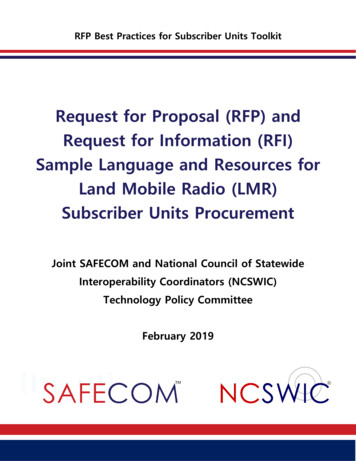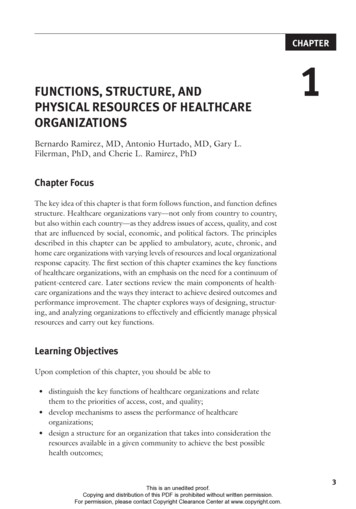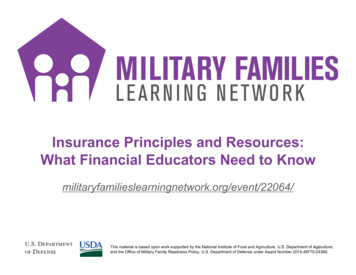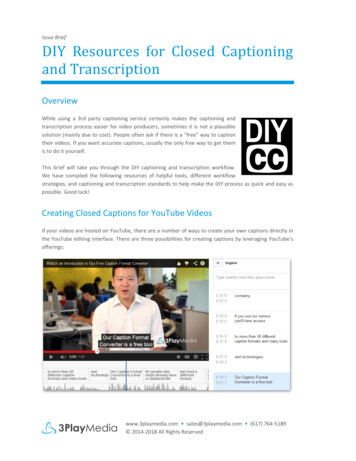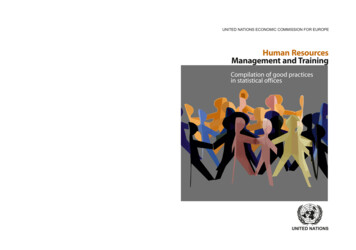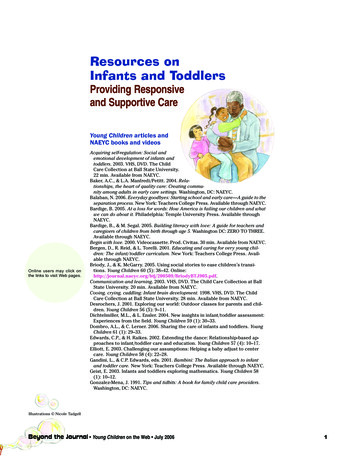
Transcription
Resources onInfants and ToddlersProviding Responsiveand Supportive CareYoung Children articles andNAEYC books and videosOnline users may click onthe links to visit Web pages.Acquiring self-regulation: Social andemotional development of infants andtoddlers. 2003. VHS, DVD. The ChildCare Collection at Ball State University.22 min. Available from NAEYC.Baker, A.C., & L.A. Manfredi/Petitt. 2004. Relationships, the heart of quality care: Creating community among adults in early care settings. Washington, DC: NAEYC.Balaban, N. 2006. Everyday goodbyes: Starting school and early care—A guide to theseparation process. New York: Teachers College Press. Available through NAEYC.Bardige, B. 2005. At a loss for words: How America is failing our children and whatwe can do about it. Philadelphia: Temple University Press. Available throughNAEYC.Bardige, B., & M. Segal. 2005. Building literacy with love: A guide for teachers andcaregivers of children from birth through age 5. Washington DC: ZERO TO THREE.Available through NAEYC.Begin with love. 2000. Videocassette. Prod. Civitas. 30 min. Available from NAEYC.Bergen, D., R. Reid, & L. Torelli. 2001. Educating and caring for very young children: The infant/toddler curriculum. New York: Teachers College Press. Available through NAEYC.Briody, J., & K. McGarry. 2005. Using social stories to ease children’s transitions. Young Children 60 (5): 38–42. TJ905.pdf.Communication and learning. 2003. VHS, DVD. The Child Care Collection at BallState University. 20 min. Available from NAEYC.Cooing, crying, cuddling: Infant brain development. 1998. VHS, DVD. The ChildCare Collection at Ball State University. 28 min. Available from NAEYC.Desrochers, J. 2001. Exploring our world: Outdoor classes for parents and children. Young Children 56 (5): 9–11.Dichtelmiller, M.L., & L. Ensler. 2004. New insights in infant/toddler assessment:Experiences from the field. Young Children 59 (1): 30–33.Dombro, A.L., & C. Lerner. 2006. Sharing the care of infants and toddlers. YoungChildren 61 (1): 29–33.Edwards, C.P., & H. Raikes. 2002. Extending the dance: Relationship-based approaches to infant/toddler care and education. Young Children 57 (4): 10–17.Elliott, E. 2003. Challenging our assumptions: Helping a baby adjust to centercare. Young Children 58 (4): 22–28.Gandini, L., & C.P. Edwards, eds. 2001. Bambini: The Italian approach to infantand toddler care. New York: Teachers College Press. Available through NAEYC.Geist, E. 2003. Infants and toddlers exploring mathematics. Young Children 58(1): 10–12.Gonzalez-Mena, J. 1991. Tips and tidbits: A book for family child care providers.Washington, DC: NAEYC.Illustrations Nicole TadgellBeyond the Journal Young Children on the Web July 20061
Gonzalez-Mena, J. 2004. What can an orphanage teach us? Lessons from Budapest.Young Children 59 (5): 26–30.Gray, H. 2001. Initiation into documentation: A fishing trip with toddlers. YoungChildren 56 (6): 84–91.Gray, H. 2004. “You go away and you come back”: Supporting separations andreunions in an infant/toddler classroom. Young Children 59 (5): 100–07.Greenberg, P. 1991. Character development: Encouraging self-esteem and selfdiscipline in infants, toddlers, and two-year-olds. Washington, DC: NAEYC.Honig, A.S. 2001. Secure relationships: Nurturing infant/toddler attachment in earlycare settings. Washington, DC: NAEYC.Honig, A.S. 2005. The language of lullabies. Young Children 60 (5): 30–36.Infant curriculum: Great explorations. 2004. Videocassette. Prod. South CarolinaEducational Television. 20 min. Available from NAEYC.Katz, L., J. Hartman, & D. Evangelou. 1990. The case for mixed-age grouping inearly education. Washington, DC: NAEYC.Kotch, L. 2004. FYI. Keeping young children safe and healthy: SIDS in childcare—What can you do? Young Children 59 (2): 48.Laughing, learning, loving: Toddler brain development. 1998. VHS, DVD. The ChildCare Collection at Ball State University. 28 min. Available from NAEYC.Laurion, J., & C. Schmiedicke. 2005. Creating connections: How to lead familychild care support groups. St. Paul, MN: Redleaf. Available through NAEYC.Lobman, C. 2003. The bugs are coming! Improvisation and early childhoodteaching. Young Children 58 (3): 18–23.Making friends and getting along with peers. 2003. The Child Care Collection atBall State University. 21 min. Available from NAEYC.McMullen, M.B. 1998. Thinking before doing: A giant toddler step on the road toliteracy. Young Children 53 (3): 65–70.McMullen, M.B. 1999. Research in Review: Achieving best practices in infant andtoddler care and education. Young Children 54 (4): 69–76.NAEYC. 2003. FYI. What we know about infants and toddlers with disabilities.Young Children 58 (3): 67.NAEYC. 2005. Relationships. From the NAEYC Accreditation Self-Study Kit. Washington, DC: Author.Odom, S.L., T. Teferra, & S. Kaul. 2004. An overview of international approachesto early intervention for young children with special needs and their families.Young Children 59 (5): 38–43.Ramming, P., C.S. Kyger, & S.D. Thompson. 2006. A new bit on toddler biting:The influence of food, oral motor development, and sensory activities. YoungChildren 61 (2): 17–23.Rice, K.F., & B.A. Groves. 2005. Hope and healing: A caregiver’s guide to helpingyoung children affected by trauma. Washington, DC: ZERO TO THREE. Availablethrough NAEYC.Robinson, L. 2003. Technology as a scaffold for emergent literacy: Interactivestorybooks for toddlers. Young Children 58 (6): 42–48.Rofrano, F. 2002. “I care for you”: A reflection on caring as infant curriculum.Young Children 57 (1): 49–51.Schon, I. 2006. Tigretón and Burrito: Books in Spanish for the young. YoungChildren 61 (2): 90–93. J.pdf.Seeing infants with new eyes [Magda Gerber]. 1984. Videocassette. South Carolina Educational Television. 26 min. Available from NAEYC.Segatti, L., J. Brown-DuPaul, & T.L. Keyes. 2003. Using everyday materials topromote problem solving in toddlers. Young Children 58 (5): 12–18.Soltero, M. 2004. Reflections on infant/toddler care. Young Children 59 (5): 30–31.Stephenson, A. 2002. What George taught me about toddlers and water. YoungChildren 57 (3): 94–96.Szamreta, J.M. 2003. Peekaboo power: To ease separation and build securerelationships. Young Children 58 (1): 88–94.Toddler curriculum: Making connections. 1991. Videocassette. South CarolinaEducational Television. 20 min. Available from NAEYC.Torquati, J., & J. Barber. 2005. Dancing with trees: Infants and toddlers in thegarden. Young Children 60 (3): 40–47.Zibulsky, J. 2002. An enriched father and son combo. Young Children 57 (6): 16–17.Beyond the Journal Young Children on the Web July 20062
Other articles, books, and videosAlbrecht, K., & L.G. Miller. 2000. Innovations: The comprehensive infant curriculum. Beltsville, MD: Gryphon House.Albrecht, K., & L.G. Miller. 2000. Innovations: The comprehensive toddler curriculum. Beltsville, MD: Gryphon House.Albrecht, K., & L.G. Miller. 2001 Innovations: The infant and toddler child development guide. Beltsville, MD: Gryphon House.Baker, A., & L. Manfredi/Petitt. 1998. Circle of love: Relationships between parent,providers, and children in family child care. St. Paul, MN: Redleaf.Bardige, B., J. Lally, A. Griffin, E. Fenichel, M. Segal, E. Szanton, & B.Weissbourd. In press. Caring for infants and toddlers in groups: Developmentally appropriate practice. Rev. ed. Washington, DC: ZERO TO THREE.Bardige, B., & M. Segal. 2004. Conversations in child care. Zero to Three 25(1): 16–22.Bronfenbrenner, U., ed. 2005. Making human beings human: Bioecologicalperspectives on human development. Thousand Oaks, CA: Sage.Bronson, M.B. 2000. Self-regulation in early childhood: Nature and nurture.New York: Guilford.Bruno, B. 1997. The infant brain: An unwritten symphony. 7/12050101.shtml.Carnegie Corporation of New York. 1994. Starting points: Meeting the needs ofour youngest children. New York: Carnegie Corporation.Clarke-Stewart, A., & V.D. Allhusen. 2005. What we know about childcare.Cambridge, MA: Harvard University Press.Cryer, D., & T. Harms, eds. 2000. Infants and toddlers in out-of-home care.Baltimore: Brookes.Cryer, D., T. Harms, & B. Bourland. 1987. Active learning for infants. MenloPark, CA: Addison-Wesley.Cryer, D., T. Harms, & B. Bourland. 1988. Active learning for twos. Menlo Park,CA: Addison-Wesley.Day, M., & R. Parlakian. 2003. How culture shapes social-emotional development: Implications for practice in infant-family programs. Washington, DC:ZERO TO THREE.Dodge, D.T., S. Rudick, & K. Berke. In press. The creative curriculum for infants, toddlers and twos. 2nd ed. Washington, DC: Teaching Strategies.Garcia, W.J. 2002. Sign with your baby: How to communicate with infants beforethey can speak. Seattle, WA: Northlight Communications.Gerber, M., & A. Johnson. 1998. Your self-confident baby: How to encourageyour child’s natural abilities—From the ver y start. New York: John Wiley.Gonzalez-Mena, J. 1997. Multicultural issues in child care. 2nd ed. MountainView, CA: Mayfield.Gonzalez-Mena, J. 2005. Diversity in early care and education: Honoring differences. 4th ed. New York: McGraw-Hill.Gonzalez-Mena, J., & D. Eyer. 2004. Infants, toddlers, and caregivers: A curriculum of respectful, responsive care and education. 6th ed. Boston: McGraw-Hill.Gowen, J.W., & J. Brennan Nebrig. 2002. Enhancing early emotional development: Guiding parents of young children. Baltimore: Brookes.Green, S. 2003. Reaching out to fathers: An examination of staff efforts thatlead to greater father involvement in early childhood programs. EarlyChildhood Research and Practice 5 (2). Online:www.ecrp.uiuc.edu/v5n2/green.html.Greenman, J. 1998. Great places for childhood: Creating children’s environments that work. Redmond, WA: Exchange Press.Greenman, J., & A. Stonehouse. 1996. Prime times: A handbook for excellencein infant and toddler programs. St. Paul, MN: Redleaf.Hamm, K., B. Gault, & A. Jones-DeWeever. 2005. In our own backyards: Localand state strategies to improve the quality of family child care. Washington,DC: Institute for Women’s Policy Research. Online:www.iwpr.org/pdf/G717.pdf.Handler, J. 2003. Infants, and toddlers as members, makers, interpreters: Aphilosophical journey. Dubuque, IA: Kendall/Hunt.Harms, T., D. Cryer, & R. Clifford. 2006. Infant/Toddler Environment RatingScale—Revised. New York: Teachers College Press.Hyson, M. 2004. The emotional development of young children: Building anemotion-centered curriculum. 2nd ed. New York: Teachers College Press.Isbell, R., & C. Isbell. 2003. The complete learning spaces book for infants andtoddlers: Fifty-four integrated areas with play experiences. Beltsville, MD:Gryphon House.Beyond the Journal Young Children on the Web July 20063
Karp, H. 2002. The happiest baby on the block: The new way to calm cryingand help your baby sleep longer. New York: Bantam.Karp, H. 2004. The happiest toddler on the block: The new way to stop thedaily battle of wills and raise a secure and well-behaved one. New York:Bantam.Koralek, D., A.L. Dombro, & D.T. Dodge. 2005. Caring for infants and toddlers.2nd ed. Washington, DC: Teaching Strategies.Leinfelder, J., & M. Segal. 2006. Coaching for quality in infant-toddler care: Afield guide for directors, consultants, and trainers. Washington, DC: ZERO TOTHREE.Lerner, C., & A. Dombro. 2004. Bringing up baby: Three steps to making gooddecisions in your child’s first years. Washington, DC: ZERO TO THREELieberman, A.F. 1995. The emotional life of the toddler. New York: The Free Press.Miller, K. 1999. Simple steps. Beltsville, MD: Gryphon House.Miller, K. 2000. Things to do with toddlers and twos. Rev. ed. Marshfield, MA:TelShare.Miller, K. 2005. Simple transitions for infants and toddlers. Beltsville, MD: GryphonHouse.National Child Care Information Center (NCCIC). 2005. Infant/toddler care andquality rating systems. Fairfax, VA: Author.New perspectives on infant/toddler learning, development, and care. 2006. Set of 3DVDs. Prod. J. Lally, for California Department of Education. 65 to 85 min.Sacramento: CDE Press.O’Brien, M. 1997. Inclusive child care for infants and toddlers: Meeting individualand special needs. Baltimore: Brookes.Oser, C., & J. Cohen. 2003. America’s babies: The Zero to Three policy center databook. Washington, DC: ZERO TO THREE.Parlakian, R. 2003. Before the ABCs: Promoting school readiness in infants andtoddlers. Washington DC: ZERO TO THREE.Parlakian, R., & N. Seibel. 2002. Building strong foundations: Practical guidance forpromoting the social-emotional development of infants and toddlers. Washington, DC: ZERO TO THREE.Pawl, J., & A. Dombro. 2001. Learning and growing together with families: Partnering with parents to support young children’s development. Washington, DC:ZERO TO THREE.Peterson, S. 2005. Early learning guidelines for infants and toddlers. Washington,DC: ZERO TO THREE.Raines, S., K. Miller, L. Curry-Rood. 2002. Story s-t-r-e-t-c-h-e-r-s for infants, toddlers, and twos. Beltsville, MD: Gryphon House.Riley, C., S. Merril, & E. O’Brien. 2000. Using sign language as a tool to communicate. Child Care Information Exchange (January): 60–62.Rosenkoetter, S., & J. Knapp-Philo, eds. 2005. Learning to read the world: Language and literacy in the first three years. Washington, DC: ZERO TO THREE.Segal, M., R. Leiderman, & W.S. Masi. 2001. In time and with love: Caring for theinfant and toddler with special needs. 2nd ed. New York: Newmarket.Shonkoff, J.P., & D.A. Phillips, eds. 2000. From neurons to neighborhoods: Thescience of early childhood development. A report of the National ResearchCouncil. Washington, DC: National Academies Press.Shore, R. 2003. Rethinking the brain: New insights into early development. NewYork: Families and Work Institute.Small, M.F. 1998. Our babies, ourselves: How biology and culture shape the way weparent. New York: Anchor Books.Stonehouse, A. 1990. Trusting toddlers: Planning for the one- to three-year-olds inchild care centers. Mt. Rainier, MD: Gryphon House.Theilheimer, R. 2006. Molding to the children: Primary caregiving and continuityof care. Zero to Three 26 (3): 50–54.Thompson, R.A. 2001. Development in the first years of life. The Future of Children 11 (1): 21–33.Time with toddlers: Training for caregivers. 1991. Videocassette. By MargieCarter. Kidspace Child Care Center. 23 min.Torelli, L. 1989. The developmentally designed group care setting: A supportiveenvironment for infants, toddlers, and caregivers. Zero to Three 10 (2): 7–10.Tuominen, M. 2003. We are not babysitters: Family child care providers redefinework and care. New Brunswick, NJ: Rutgers University Press.Zepeda, M., J. Gonzalez-Mena, C. Rothstein-Fisch, & E. Trumbull. 2006. Bridgingcultures in early care and education: A training module. Mahwah, NJ: Erlbaum.Zigler, E.F., M. Finn-Stevenson, & N.W. Hall. 2004. The first three years and beyond: Brain development and social policy. New Haven: Yale University Press.Beyond the Journal Young Children on the Web July 20064
Web sites, programs, and organizationsCopyright 2006 by the NationalAssociation for the Education ofYoung Children. See Permissions and Reprints online er Brains for Babies is a collaboration of state and local public and privateorganizations dedicated to promoting awareness and education about theimportance of early brain development in the healthy growth and development of infants and young children in ers is designed to provide parents, caregivers, and pediatric andfamily clinicians with meaningful information about early brain developmentand the relationships between babies and their parents and caregivers thatsupport intellectual and social-emotional development.www.zerotothree.org/brainwondersCenter for Prevention and Early Intervention Policy focuses on maternal andchild health and early childhood issues. Provides numerous resources forprofessionals working with young children. www.cpeip.fsu.eduEarly Head Start National Resource Center (EHS NRC) supports high-qualityservices to Early Head Start and Migrant Head Start expectant parents andfamilies with infants and toddlers through People Networks and CommunicationSystems, Knowledge Building, and Program Development. www.ehsnrc.orgFrank Porter Graham Child Development Institute is a multidisciplinary institute at University of North Carolina at Chapel Hill. The institute’s mission is tocultivate and share the knowledge necessary to enhance child developmentand family well-being. www.fpg.unc.eduHigh/Scope Educational Research Foundation promotes the development ofchildren and youth worldwide and supports educators and families as theyhelp children learn. High/Scope develops curricula, trains teachers, conductsand publishes research, and publishes educational books, many related toinfant and toddler growth and development. www.highscope.orgMind in the Making shares the science of early learning with those who careabout children’s learning and tional Child Care Information Center (NCCIC) is a national clearinghouseand technical assistance center that links families, providers, policy makers,researchers, and the public to early care and education information.www.nccic.orgNational Infant and Toddler Child Care Initiative at ZERO TO THREE workscollaboratively with Child Care and Development Fund administrators andother partners to move forward system initiatives to improve the quality andsupply of infant and toddler child care. www.nccic.org/ITCCNational Network for Child Care shares knowledge about children and childcare with families, professionals, practitioners, and the general public. Theirresources include online communities, state specific information, e-mail newsletters, and conference information. www.nncc.orgOhio’s Infant/Toddler Guidelines are seen as the critical first step to ensuringthat all Ohio children, birth to three, have responsive, reciprocal, and respectful care. These guidelines can be used by other states and programs as amodel. C, The Program for Infant/Toddler Care promotes responsive care forinfants and toddlers with its many resources and programs. www.pitc.orgResources for Infant Educarers (REI) has a unique approach based on respectthat helps raise infants who are competent, confident, curious, attentive,exploring, and more. www.rie.orgTeaching Strategies offers practical, innovative, and developmentally appropriate curriculum materials, training services, training materials, and parentingresources for children birth through age eight. www.teachingstrategies.orgWestEd is a nonprofit research, development, and service agency that promoteslearning for infants, toddlers, youth, and adults. The organization offers manyresources and materials for those working with infants and toddlers.www.wested.orgZERO TO THREE provides numerous resources that support the healthy development and well-being of infants, toddlers, and their families. Its Policy Network is a vehicle for professionals to use their knowledge and expertise toaffect public policy. www.zerotothree.orgBeyond the Journal Young Children on the Web July 20065
The happiest baby on the block: The new way to calm crying and help your baby sleep longer. New York: Bantam. Karp, H. 2004. The happiest toddler on the block: The new way to stop the daily battle of wills and raise a secure and well-behaved one. New York: Bantam. Koralek, D., A.L. Dombro,
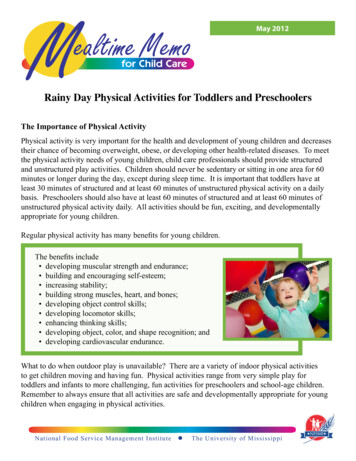
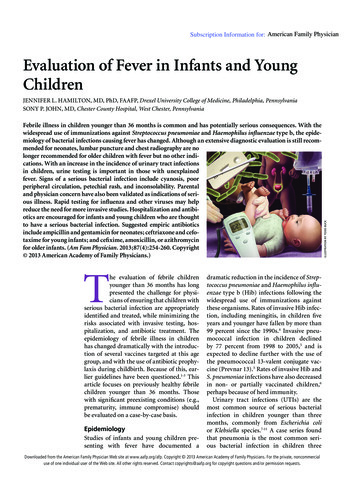

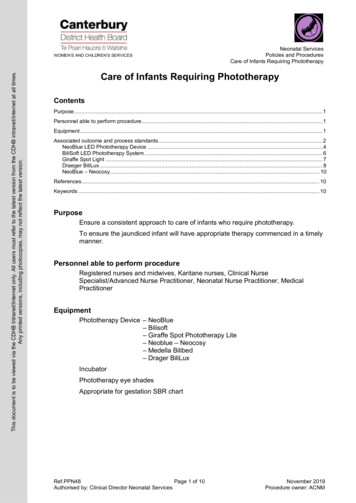
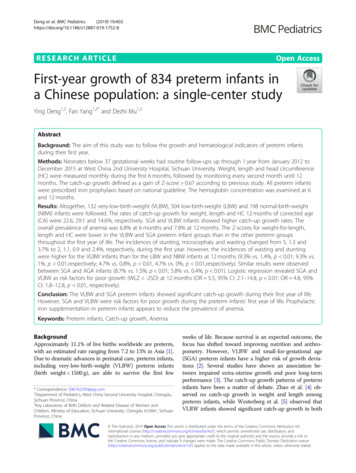
![[IV‐ADV‐9‐A] Tips and Tricks for Payroll and Human Resources](/img/9/tips-and-tricks-payroll-and-hr.jpg)
